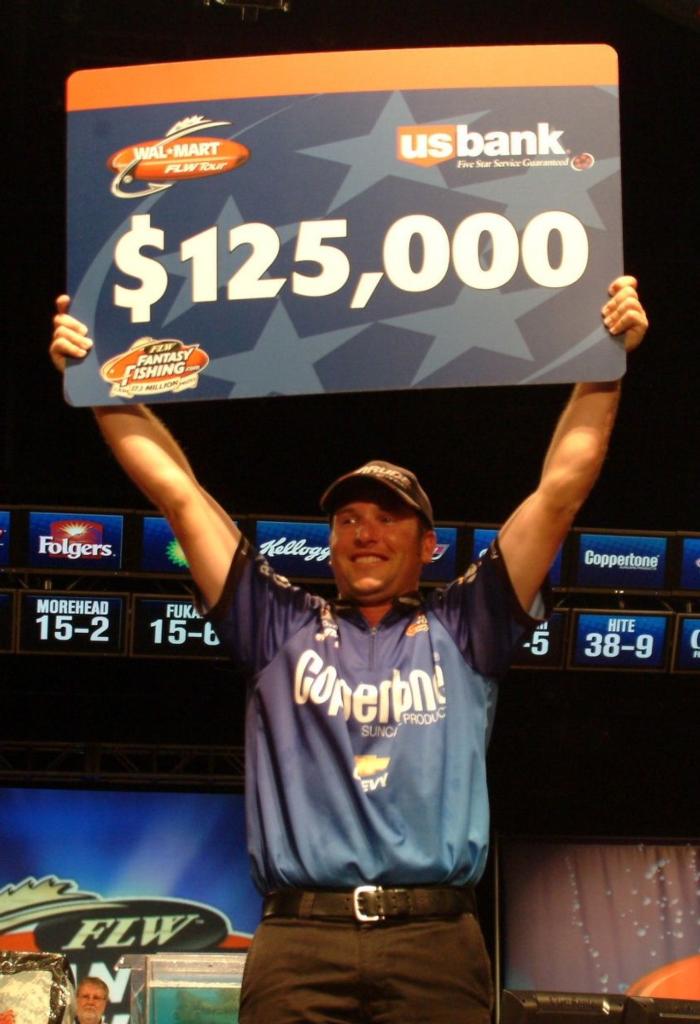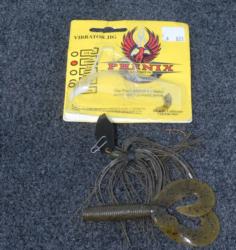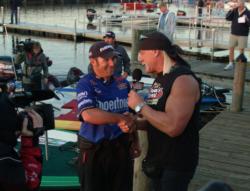Reel Chat with BRETT HITE

– MODERATOR COMMENT –
Welcome to FLW Live Reel Chat. Today we’re joined by FLW Tour pro Brett Hite of Phoenix. As the winner of the recent 2008 FLW Tour event at Lake Toho, Hite already boasts over $276,000 in career earnings from FLW Outdoors-related events. Since the inception of his FLW Outdoors career in 2003, Hite has amassed two major victories – the 2008 FLW Tour event at Lake Toho as well as the 2003 Stren Series Western Division event at Lake Pleasant. Hite has also notched two other top-10 appearances – a third-place finish at the Stren Series California Delta event in 2003 and an eighth-place finish at the FLW Series Western Division event at Clear Lake in 2007.
– MODERATOR COMMENT –
With the successful Forrest Wood Cup championship runs of fellow Western anglers Luke Clausen and Brent Ehrler in recent years, it’s clear that the Arizona native is yet another “young gun” poised to make plenty of noise on major bass-fishing circuits for the foreseeable future. Today, Brett Hite is here to take questions from you, the fans. So, without further delay, let’s get started.
Q: How important to you was getting your first-ever FLW Tour win at Lake Toho?
— Jon Stebbins (San Diego, Calif.)
A: It’s the biggest highlight of my career. I’ve qualified for the Bassmaster Classic and Forrest Wood Cup, but this is my biggest accomplishment. Definitely.
Q: How would you rate this win next to your team win at the El Cajon Ford Open?
— Wahoo (San Diego, Calif.)
A: It’s definitely a lot bigger win than the El Cajon Ford Open. I’ve had a pretty good fishing career so far. But there aren’t too many people who win tour events. There are only six of the year. And you have all the top fishermen there. It’s not just the best of the West or best of the East. It’s the best of the best. So it’s a nice win to have.
Q: How is fishing an FLW Tour event different than fishing a BASS event?
— Matt Arneson (Lenoir City, Tenn.)
A: They are fairly similar. FLW tournaments are run a little bit more smoothly. FLW officials really care about what you have to say as an angler, and the organization is really good about answering any questions you might have.
Q: Is the Phenix Vibrator jig from the same company that made Clayton Meyer’s football-head jig from Amistad? If so, that’s back-to-back wins, and I’ve never even heard of them.
— Randy S. (Moline, Ill.)
A: Yes, it’s the same company. A lot of those baits are real similiar, but it’s got a nice paint job on the head, a nice skirt and a good hook. With that swimming Senko on the back, it really made the bait look like a shiner or a bluegill, and I think that was key to getting bigger bites. The bigger fish were really keyed in on that bait, I think, because it had a bigger profile.
Q: How does the Phoenix Vibrator jig compare to the ChatterBait? How did you decide that a grub would be the best trailer? Where can a weekend angler purchase the vibrating jig?
— Dan Rhoal (Mount Dora, Fla.)
A: All ChatterBait-(style lures) are pretty similiar. I just like everything about this particular one. I like the black blade. I like the skirt. It’s basically identical to the ChatterBait. As far as the trailer, I like something that is dark to represent a bluegill. I also wanted to use a trailer that was a little bit bigger. You won’t get as many bites, but when you do, the fish will tend to be bigger. Right now, I don’t know of any online store that carry it. I’d recommend calling Fishermen’s Choice at: (602) 993-1139. If you call that number, they can probably send you out some.
Q: How many bites per day were you averaging in practice? Did you know at the time that you were around such quality fish?
— Nick Lee (Cartersville, Ga.)
A: In practice, some days were better than others. But on the good days, I was getting 10 bites a day. The bites I were getting were 2- to 3 1/2-pound fish. So I was gambling a little bit that the bigger fish were around there. The second day of practice I found my winning spot. I actually went through another day of tough practice, but I stumbled upon a secondary area that helped me as well.
Q: What was the biggest hurdle you faced coming out East and trying to compete on water that was relatively unfamiliar to you?
— Jon Pageler (New York City, N.Y.)
A: I’d fished Lake Toho three or four times prior, so I was kind of familiar with the water. In Florida, you really have to focus on minute changes. In Florida, I was looking for small depressions, etc. The biggest challenge fishing out East was learning how to really fish grass. That’s probably the one area I’ve really focused on, and now I’m doing a lot better at it. And that’s helped.
Q: Not only did you win your very first FLW Tour event on Lake Toho, but you basically dominated the rest of the competition in the process. How were you able to pull off that feat with relative ease against some of the best anglers in the country?
— Tim Halverson (Los Angeles, Calif.)
A: A lot of people had found the same areas I had found. But looking at the surroundings and finding a key bait was important. Where I was, everybody was flipping. So I wanted to try something different than what everybody else was doing. I was throwing a Chatter-style bait with a Yamomoto Swimming Senko on the back. I used a steady, medium retrieve, and just something about that was key to the bigger fish biting.
Q: What are the main differences between fishing Western bodies of water and Eastern fisheries?
— Pat Zak (Oakland, Calif.)
A: Western fishing is a lot better (laughing). Seriously, they’re fairly similar. Western fisheries are generally a little deeper. A good structure lake out East, you’re talking about 25 to 30 feet. Out West, a good structure lake would come in at around 60 feet. Fishing areas back East are a little fatter and a little more subtle, like the breaks and stuff. In the West, we have more canyon-type lakes, so there are going to be steeper drops. The water out East is flatter, and the breaks and underwater topography aren’t as extreme.
Q: Congrats to you on your win.  Being from Arizona, what is the best fishery closest to the Phoenix DMA?
Being from Arizona, what is the best fishery closest to the Phoenix DMA?
— Matt Anselm (Kansas City, Mo.)
A: Roosevelt Lake, by far. The next three years, Roosevelt lake is going to be one of the best fisheries in the entire western United States.
Q: How has the recent algae bloom affected fishing in Arizona lakes like Apache, Canyon and Roosevelt, and will the lakes ever recover to become great fisheries again?
— Kevin O’Hagan (Tinley Park, Ill.)
A: The algae has actually devastated Apache, Canyon and Saguaro lakes. Luckily, this year we’ve gotten a lot of runoff, and I think that’s helped to flush those lakes out. They’ve been doing some restocking and habitat programs, and hopefully the lakes will come back. But I think it’s going to take a few years.
Q: Are you really typing this stuff right now? How many words do you type per minute?
— Slam (Kansas City, Mo.)
A: Editor’s note: Brett Hite is being asked questions over the phone right now, but the answers are being typed by an FLWOutdoors.com editor, who types quite quickly, as you can see.
Q: Since I forgot to put you on my Fantasy Fishing team for Toho (big mistake), what other lake should I put you on this year?
— Mike (Oxford, N.J.)
A: Smith Lake. Beaver Lake. You know, just put me on all of them because I’m planning on doing well all year.
Q: How is practice going on the Delta? What phase are the fish in? Are we going to see huge sacks like usual?
— Chris Gelhurn (Stockton, Calif.)
A: Practice, the numbers are down. They are in a prespawn pattern. But the bites you do get are good-quality fish. And, yes, you’re going to see some giants weighed in this week. I’m guessing you’ll see some 12- to 14-pounders weighed in.
Q: Brett, I have used the ChatterBait-style swimming jigs in Michigan when fishing weedbeds and lanes through the weeds like you did on Toho. Would you use this technique on a vegetation-free lake like Table Rock during the prespawn, or is there a better technique?
— Ed Dyer (Byron Center, Mich.)
A: You definitely could. I think the situation with grass is the ideal situation. But I do catch them in open reservoir-style lakes with that bait, but just not as good. In prespawn on Table Rock, I’d probably use a Wiggle Wart or some kind of swimbait.
Q: I am looking to do more drop-shotting this summer and would like to hear your setup as far as rods, reels, line, bait, hook and weight for Northern natural lakes with a lot of grass.
— Eric Schultz (Wayzata, Minn.)
A: I would have two different rods and reels set up. The first is a spinning rod with 6- to 8-pound-test (line) with an 1/8-ounce drop-shot weight with a 1-0 Roboworm rebar hook. The worm would either be a Yamamoto 9M Senko or a 6-inch fat Roboworm in whatever color you have confidence in. The second setup I’d use is a medium-heavy baitcaster with 12- to 16-pound-test of Sunline fluorocarbon with a 2-0 Roboworm rebar hook. I’d go with a 6- to 7-inch bait like a Yamomoto 7X cuttail worm. I’d also consider a 6-inch fat Roboworm.
Q: In your opinion, why do you think Western anglers have had so much success on the FLW Tour over the past few years?
— David Perlman (Minneapolis, MN)
A: I think our versatility is the biggest key. We’re able to finesse fish and power fish. I really think that the different lakes we have out here give us a lot of confidence. You can pretty much find any type of lake out here, and it forces you to really master a variety of different techniques.
Q: What made the spot you were fishing so special on Lake Toho? Why were the other competitors not able to find those quality fish?
— Tally (Potosi, Mo.)
A: The bait I used and having a lot of patience helped. Meticulously picking the area apart was also a key decision. As I said earlier, there were others on this spot. I just looked at the area a little different way than some of the other anglers.
Q: Brett, congrats on the win. Two questions: How did you go about getting a sponsor deal such as Coppertone? Also, did you find those fish on the southeast side of Kissimmee?
— Jason Guynn (Ocala, Fla.)
A: I didn’t catch my fish on the southeast side of Kissimmee. As far as sponsorships go, FLW Outdoors really helped me out. But it takes a lot of hard work, being able to really do good things for your sponsors, being able to speak well and represent the company well. You also have to be a good fisherman. Basically, you want to work on having the complete package. And then sponsors will be interested in you.
Q: Obviously, many Western anglers have found success on the FLW Tour over the past few seasons. In your opinion, who are some other lesser-known Western sticks who bass-fishing fans should expect to hear more about in the next few years?
— Pete Engeldinger (St. Peter, Minn.)
A: There are some guys from out West who are doing well right now, but who haven’t won a tour event yet. But you’re going to keep hearing about them in the next couple years. Michael Bennett and Gabe Bolivar are two names that come to mind. Tim Klinger is another guy.
Q: How does the boat and motor affect your success or failure in tournaments?
— Angie (Paducah, Ky.)
A: You always have to get to the spot and get back. I’m running a Ranger Z520 with an Evinrude 250 HO. It’s the best high-speed, all-around fishing boat I’ve had. Speed just gives you more time to fish. And the setup also gives me good fishability; I can really maintain my position on the lake.
Q: Brett, how did you decide on Kissimmee? All those lakes can produce big strings.
— Jeffrey (Lakeland, Fla.)
A: I think in practice you need to come up with a game plan. But Kissimmee is a huge lake, and you only get four days of practice. So you need to make up your mind where you’re going to fish first. That way you can be more efficient and try to keep your areas relatively close to each other. I just decided I was going to stay in Kissimmee because I didn’t want to have areas in Toho and Kissimmee, because then you wind up running around the whole time. One of the mistakes people make in practice is that they spend the whole time running all over the place instead of concentrating on certain areas and figuring out where  the fish are in more manageable sections of the lake.
the fish are in more manageable sections of the lake.
Q: Brett, what is the hardest thing about being a pro angler?
— Sean Sills (Metter, Ga.)
A: Driving is probably one of the biggest downfalls. Being away from home is another one. I don’t have a family, but there is nothing like sleeping in your own bed. People think bass fishing is a glorious thing, which it is. But a lot of people don’t really know how hard it is. I mean, just go fishing for a week straight, logging 10-hour days on the water the whole time. It’s a much more grueling sport than people give it credit for.
Q: Did it hurt when Hulk Hogan shook your hand before Sunday’s takeoff?
— Wrastling rules (Indianapolis, Ind.)
A: No. I hurt his hand.
– MODERATOR COMMENT –
Bass-fishing fans, unfortunately, that’s all the time we have for Brett Hite as of right now. However, FLWOutdoors.com will continue to provide as many installments of the FLW Live Reel Chat series as possible as we head deeper into the 2008 season. Again, thanks to Brett Hite for giving us his valuable time as he prepares for the FLW Series event on the California Delta this week. And a very special thanks to all of the fans who participated in today’s Reel Chat program on FLWOutdoors.com.